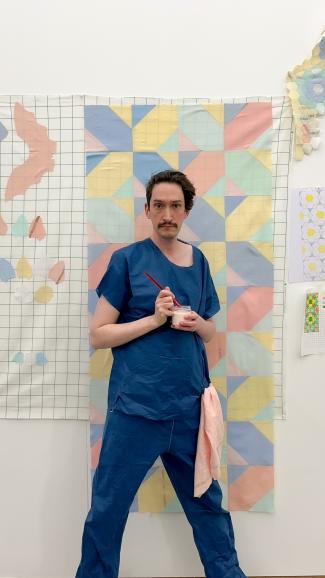Benoît Piéron | Exhibition Coming Soon
Benoît Piéron works on creating moments, installations, and objects exploring the sensuality of plants, the limits of the human body, and the temporal nature of waiting rooms. His creative journey covers various practices, including patchwork, existential gardening, and wallpaper creation.
Affected by a long-term illness, Benoît Piéron maintains a very close relationship with the hospital ecosystem. He has developed a practice inspired by this environment and seeks to lend a plasticity to illness. Far from the romantic heroism of typical metaphors for disease, Piéron positions himself in a joyful gray area. Through his art, he strives to explore these uncharted territories, viewing them not as a burden but as a potential source of creative expression.
Selected exhibitions: Coming Soon, Lafayette Anticipations, Paris (2024); Slumber Party, Chisenhale Gallery, London (2023); Der pinkelnde Tod, Kunstverein Bielefeld, Bielefeld (2023); Avant l’Orage, Bourse du Commerce, Pinault Collection, Paris (2023); uMoya: The Sacred Return of Lost Things, Liverpool Biennial, Liverpool (2023); Exposé.es, Palais de Tokyo, Paris (2023); Horizones, Fondation Pernod Ricard, Paris (2022); Bandage, galerie du Haïdouc à l’Antre Peaux, Bourges (2022); Illness Shower, Sultana Summer Set, Galerie Sultana, Arles (2022); Deux drapeaux, Une Belladone, L’alcôve, Paris (2021); VIH/sida, l’épidémie n’est pas finie, Mucem, Marseille (2021); Plaid, Cité internationale des Arts, Paris (2021); Mort is more, Brasserie Atlas, Brussels (2021).
Transcript
Hello, my name is Benoît Piéron and I am an artist. Most of my work is patchwork, soft-toys, I also do gardening with lethal plants, but above all I’m speaking from a place that is a bit unattainable, but in the end I share it with everyone: it’s a collective intimacy, it’s my body. And my body is specific in that it is disabled. And finally, in this flat, it’s a bit like a shared flat that I’m sharing with a “companion disease”. It’s an expression I borrow from Claire Marin and in the end that’s what it’s all about, working with and from it, in the velvet of the disease empire, to succeed in giving an alternative form and plasticity to diseases.
Laundrette is an immersive experience. We enter a laundrette where every element has been thought of, including the temperature of the light, of the linoleum and colour on the walls. These are three washing machines and benches to experiment this stretched out tile and inside the washing machines, they are transformed into light machines. Inside, there are flashing lights, and also, the porthole has been modified with a glass with diffraction properties and there are elements inside that play on these diffraction effects kaleidoscopic, like all optical toys. So there’s this idea that something very banal can give you access to a visual experience of space. This laundrette is also unique, because the running time of the machines is not programmed. The programme itself has been cancelled by the impermanence of the disease. You can’t plan anything when you’re sick.
Laundrette is a laundry, a place where people come to wash their clothes. It’s a very special place, because I’ve been using in my work for a few years, used hospital linen. The sheets still bear the marks of the previous users. And in hospitals, there are still “clean stains” as nursing staff call them, stains that can’t be washed off so it is recycled. The fabric is then recycled, during the waste recovery circuit, they are sent to a laundry for cutting, and literally mince them, then it is sold at LeroyMerlin for making rags to wash the car or the painting. That’s where I get them back and I create a patchwork, in other words, something collective that still bears the marks of all those previous users.
The laundry is the only place where all of a sudden, we’re going to come out our underwear without shame and show them off in a kind of theatre that’s very special, that there’s no shame in and all these phylacteries of ourselves, all these skins that we take out of the machines that we spread out for others to see. I thought it was very very beautiful. The laundries are places of exhibition of collective intimacy but they are also places with a social dimension. Not everyone will go to the laundrette, it’s also linked to precariousness in some cases and what interested me was to fill these washing machines with light. Light is something that interested me because it’s a key subject, it can be light and shadow and it has relation to intimacy too. Flashing lights are the light of power, the light of urgency, the Violent light, which is also the light of the police, which is also the light of medical power, which sees inside bodies. And at the same time, all my work is to take this light and turn it into something sweet, to soften it and turn it into something that could even be relaxing.
